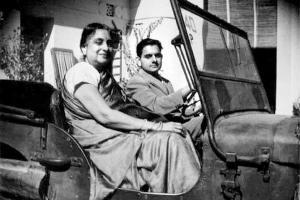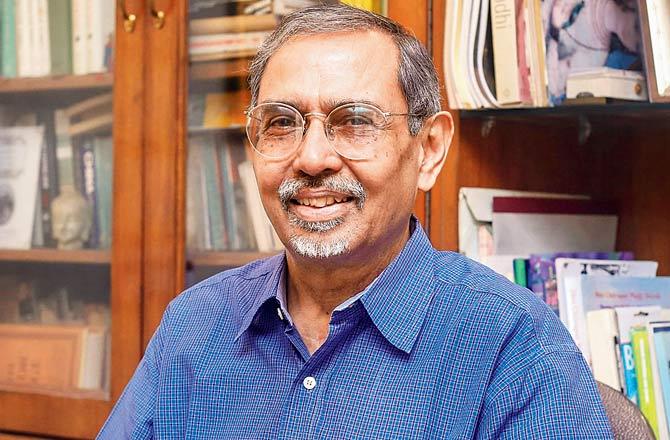Not willing to let their community's glorious past fade, a former diplomat and a journalist collaborate online to highlight the literary works of Chitrapur Saraswat Brahmins

Kamaladevi Chattopadhyay (nee Dhareshwar) with her son, Ramakrishna
It was in the winter of 1965 that Dr Frank Conlon, professor emeritus, University of Washington, came to Bombay to study the impact of the adjudication of caste and community disputes by British courts. This meant doing the rounds of Elphinstone College, Kala Ghoda, to dig into Maharashtra archives to unearth relevant material for his doctoral dissertation. But, little did he know that a dreary afternoon at the Bombay GPO would change his course of action.
ADVERTISEMENT
While standing in queue, Conlon's attention was momentarily distracted by two men on the verge of a scuffle. In the ensuing melee, a stranger picked up his briefcase and walked away imagining the foreigner's bag to be full of valuable goods or money. "All they got was a collection of notes that I had laboriously made over the past five months in London and Bombay," says the Seattle-based Conlon in an email interview.

Sadashiv Rao, lawyer and social reformer
With no backup, he entered 1966 with no material for his dissertation. "I always wondered if my notes ended up as paper cones for snack vendors," he jokes. But the incident propelled him into a whole new direction; one that would lead to a chance conversation with an American friend, who would introduce him to Sadanand Bhatkal. A Chitrapur Saraswat Brahmin, Bhatkal ran a publishing house in Lamington Road, and referred him to the Kanara Saraswat Association: the starting point of his study. The series of "wonderful accidents" culminated into Conlon penning a pioneering account titled, 'A Caste in A Changing World: The Chitrapur Saraswat Brahmans, 1700-1935', the only published work on the community, whose contribution is intrinsically linked to the history and growth of the country. This was in June 1977.
A second chance
Cut to present. After being out of circulation for almost 20 years, Conlon's book has found a new lease of life on www.chitrapurebooks.com, an initiative by Jaishankar Bondal, a former member of India's diplomatic service, and Shantish Nayel, a Bengaluru-based TV media consultant. It turns out, the book had a rather small press run in India because Conlon wasn't going to follow up on a revised edition.

Shantish Nayel, co-founder
But, Bondal and Nayel want to ensure any significant piece of literature on the Chitrapur Saraswat Brahmins (CSB) is not lost. The community evolved from a cluster of Goud Saraswat Brahmins who had migrated from north India to Mangalore. Today, they are scattered all over the world, and their count stands at 25,000, fewer than the Parsis. "Which is why when we began the project we thought our community is only a little over 300 years old, so at the most there might be a couple of hundred books. But, to our surprise, we have already crossed 3,200 titles," says Nayel, who along with Bondal initiated the project in 2014. Both agree that this is just the tip of the iceberg.
In fact, the duo recently announced the release of a bonanza of digitised books. The 10 new volumes range from biographies and political accounts to philosophical commentaries, and chronicle contributions by members of the community who played a key role in developments in India of the 20th century. "Despite hailing from the community, I, for a long time, did not know that Kamaladevi Chattopadhyay, originally hailed from a Chitrapur Saraswat family [nee Dhareshwar] of Mangalore," says Bondal, who resides in Gurgaon.

J Bondal, co-founder. Pic/Nishad Alam
While most Indians might identify her as the figure who revived Indian handicrafts, she was also the first woman in India to contest (and lose by a narrow margin) an assembly election in Madras Presidency, and also the only lady who took up cudgels with Mahatma Gandhi to include women in the Salt Satyagraha when the Satyagrahis marched to make salt at Chowpatty in 1930s. Apart from Chattopadhyay, Nayel says there are several other notable Chitrapur Saraswats whose contribution might not be known outside the community.
Take, for instance, Umabai Kundapur, who helped create Mahila Dal of the Indian National Congress and served along with Sarojini Naidu and Aruna Asaf Ali to mobilise women in the national movement. She helped shape the All India Women's Conference to take up the cause of what is today a 'trending' movement — gender equality. There's also Sadashiv Rao, a successful lawyer turned social reformer, and principal organiser of the freedom movement in Karnataka.
Sticking to the original
To acquire the rights to publish the articles and books, Nayel and Bondal approached the nearest family members to seek permission in writing. Incredibly, the 51-year-old admits he had to manually type the surnames of over 500 Chitrapur Saraswat families on search engines to find material published by them. "As word spread, many families approached us with books," he says.
Currently, a total of 35 books, over 100 articles from vintage articles by (and about) community members, along with photogalleries, make up the website. A primary source for the material were articles published through a Bombay-based community broadsheet titled the 'Kanara Saraswat Quarterly', which soon became the 'Kanara Saraswat' monthly; it continues to this day. Here, many eager opinions were expressed on paper and the ambit of ideas expanded from local to provincial to national. "As education spread, so did the mobility of people and of ideas. Women contributors increased. The editor of the quarterly was even arrested by the British for 'anti-national' activities," says Bondal, adding that once the magazine resumed publication, there was a letter from the editor apologising for the discontinuity.
The period also witnessed the emergence of the idea of the co-operative housing society by Rao Bahadur SS Talmaki in Bombay, who set up Saraswat Colony, the city's first such settlement. Interestingly, when Bondal was working in the Indian Embassy in Beijing as a diplomat, he recalls a group of Chinese urban planners approaching him to find out about Talmaki. "I was amazed that the Chinese knew about him while most Indians didn't," he says.
The beginning of modernisation
It's the colonial introduction of British administration and migration to Bombay in the early 20th century that marks the beginning of the modern history of the community. A look at the titles offers a glimpse into the preoccupations of the community from 1900-1935. These include essays on the need for Hindi among Saraswats (Kamaladevi Sunderrao Dongerkery), the advantages and disadvantages of late marriages (G Annaji Rao) and exercise for women (Leelabai Koppikar).
"While there was always high literacy in the community, there were some customs which would now appear ludicrous, such as no-inter dining and boycott of those who travelled abroad," says Nayel. Conlon, too, agrees that there was resistance to change at the time. "The guru of the Shri Chitrapur Math — the spiritual leader of the community — was concerned that life in Bombay could not be lived consistent with traditional practices. It was only in the 1930s that a reconciliation led to a reintegration of the community."
But, if there's one question that continues to baffle the community, it's the question of their origin. "I regret to announce that I still have not settled the matter to my satisfaction," says Conlon. Bondal says, "When we migrated from the north, the king in Kanara region asked us who we were. It's a question we get even to this day," he laughs.
Catch up on all the latest Mumbai news, crime news, current affairs, and also a complete guide on Mumbai from food to things to do and events across the city here. Also download the new mid-day Android and iOS apps to get latest updates
 Subscribe today by clicking the link and stay updated with the latest news!" Click here!
Subscribe today by clicking the link and stay updated with the latest news!" Click here!






